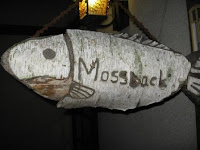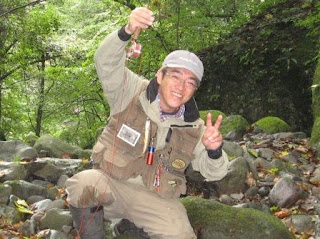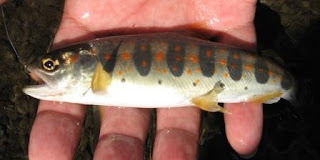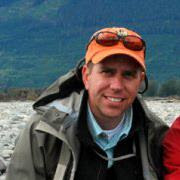Just one week after the Nikengoya trip I had the opportunity to go to another beautiful fishing area North of Mount Fuji. I went with Kawano-sensei, Tanaka-san and my wife Susanne. It was a cool overcast weekend with off and on rain showers. We stayed at the Seisen_Ryo hotel and had a private 2 bedroom cottage. The price was very reasonable which included breakfast and dinner in a 4 star restuarant.
We arrived Sunday evening and visited a famous fly-fishing hangout called Mossback.

It is a small diner with lots of atmosphere. The owner, a friend of Dr. Kawano, is a local with a lot of knowledge of this area's streams. We had coffee and looked at books of nature photographs taken by the owner. After coffee, the owner brought out some topo maps and showed us the best places to go.
That afternoon, we checked into the hotel and donned our fishing gear. The first stream was close to town. We spreadout with about 100 meters between us. I was in the middle close to a bridge. I walked slightly down stream near a small falls and started fishing back up stream. I was using a newly tied pattern (Olive CDC caddis on a #14 extra fine hook). It is a very high floating fly that likes to "skitter" on the surface film. Iwana seem to be attracted to this natural movement.
I saw a very likely spot and I slowly fished my way to it. It was a group of large rocks against the far shore. They formed a series of small falls with shallow pools between them. I fished the lowest pool first with no results. My fly was starting to sink, so I redressed it with some powder floatant. I knew the next pool was probably my best chance. The fly landed softly just above the eddy and floated for about 3 seconds before I had a strike. It was a nice Iwana (about 21 cm). I held it up for Dr. Kawano to see and took some pictures.

Soon after this, Tanaka-san saw five fly fisherman walk downstream and leave. Evidently this area had been recently fished. I was very lucky to have caught a fish here.
The next morning we hiked down a gorge to a very popular stream. When we arrived Dr. Kawano and I sat down to rest. Tanaka-san immediately started fishing. We watched as Tanaka-san made beautiful casts to a large pool right in front of us. An Iwana attacked his fly and he set the hook perfectly.

It was very enjoyable to see him catch his first trout of this trip. He has been fishing for 10 years and is a very skilled angler.
We then split up and spreadout along the stream. Dr. Kawano caught two Iwana and Tanaka-san caught a total of three Iwana. I was happy that everyone was catching fish. We came back together and had a bento lunch. Next we went to one of the streams suggested by the Mossback owner. I caught a very dark colored Iwana-char here. Dr. Kawano said he believed this was probably a native "wild" trout.

It gets a little confusing sometimes. But many of the streams in Japan contain stocked trout that are raised in hatcheries. They are still Iwana trout which is a native species. The co-ops that release the fish may only stock the stream once every three years to offset high pressure fishing areas. These "farm raised" Iwana interbreed with the natural "wild" Iwana and it leads to changes in there appearance. Most noticeably, they appear lighter in color. However, many of the small streams are cut-off from the large streams by dams and large waterfalls that keep these areas "wild".
By the way, Susanne also enjoyed herself soaking in the onsen, shopping and making new friends. Such is the life of a fishing widow.














